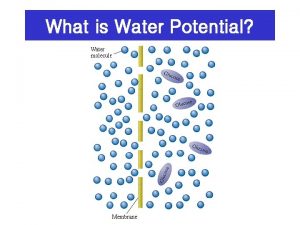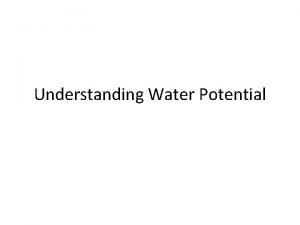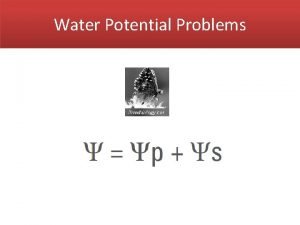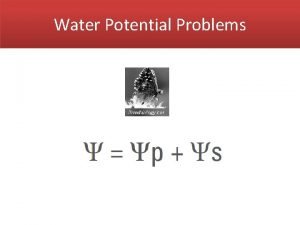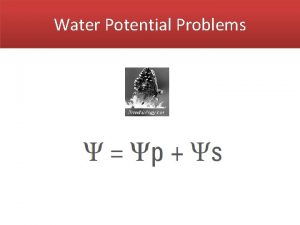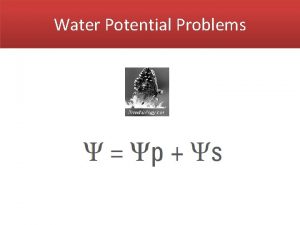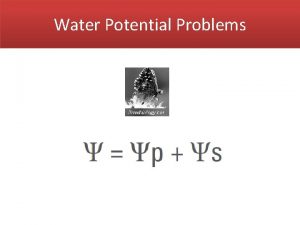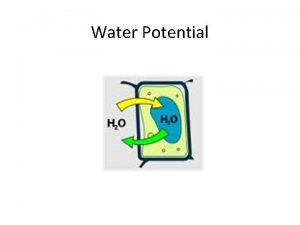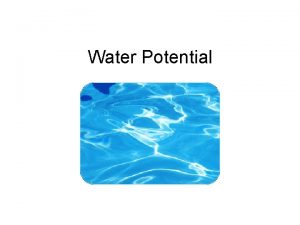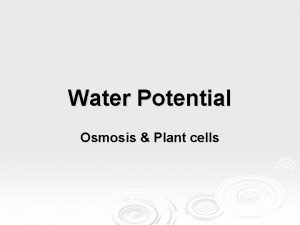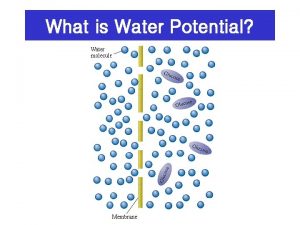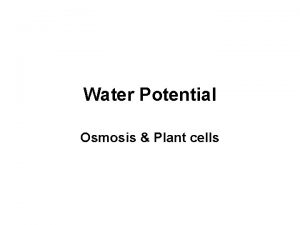Water Potential Tutorial A What is water potential
























- Slides: 24

Water Potential Tutorial

A. What is water potential? • Water potential is the force responsible for the movement of water in a system. • It is a measure of the free energy of water, which is lower when it has to surround solutes. • Pure water (no solutes) has a water potential of zero. As more and more solutes are added, water potential becomes more negative. • Water potential is given the symbol psi ( ) and is measured in bars or megapascals

B. What are the factors that affect water potential? • Solute potential (also called osmotic potential) has the symbol ( s) and is determined by solute concentration. In pure water, the solute potential is zero. As more and more solutes are added, solute potential becomes more negative. • Pressure potential has the symbol ( p) and results from exertion of pressure on cell membranes/walls as water moves into the cell. It is typically a positive value. • The equation that describes the effects of solute potential and pressure potential on water potential is given below. Calculation #1: = s + p

C. So how does the movement of water relate to water potential? • Water moves from areas of higher water potential (i. e. high water concentration, low solute concentration) to areas of lower water potential (i. e. low water concentration, high solute concentration) • When enough water has moved so that two solutions are in equilibrium with each other, they will have equal water potentials. Let’s draw a diagram!


A diagram that includes actual numeric values for water potential and solute potential

Changes in pressure potential and water potential when a plant cell is placed in hypotonic solution ***Notice that when the plant cell reaches equilibrium with the external solution (distilled water), the water potential inside the cell is equal to the water potential of the external solution! At Equilibrium

D. If you know the molarity (concentration) of solute in a solution, how do you find the solute potential? • You use the calculation given below: Calculation #2: s = -i. CRT • The variables for this equation are defined as follows: • i = ionization constant (1 for a solute that does not dissolve / break apart in water, 2 for a solute like Na. Cl that breaks apart into two ions – Na+ and Cl-) • C = molar concentration of the solute • R = pressure constant (0. 0831 liter/bars/mole K for sucrose) • T = temperature in Kelvin (degrees Celsius + 273)

Practice Problem #1 The initial molar concentration of the cytoplasm inside a cell is 2 M and the cell is placed in a solution with a concentration of 2. 5 M. For each statement below, write A if the statement is true and B if the statement is false. If the statement is false, please correct it.

a) Initially, free energy is greater inside the cell than outside Answer: A (True) Explanation: High free energy higher water potential higher water concentration

b) It is possible that this cell is already in equilibrium with its surroundings. Answer: B (False) Explanation: The cell must lose water to reach equilibrium with the outside solution

c) Initially, solute concentration is greater outside the cell than inside. Answer: A (True) Explanation: See picture

d) Water will enter the cell because solute potential is lower inside the cell than outside. Answer: B (False) Explanation: Water will exit the cell because solute potential and water potential are higher (less negative) inside the cell than outside the cell

e) Initially, the cytoplasm is hypertonic to the surrounding solution. Answer: B (False) Explanation: Initially, the cytoplasm is hypotonic to the surrounding solution.

f) At equilibrium, the pressure potential inside the cell will have increased. Answer: B (False) Explanation: At equilibrium, the pressure potential inside the cell remains zero. There is only pressure potential when water enters a plant cell and pushes against the cell wall to create pressure.

Practice Problem #2 A student conducted an experiment to track the movement of water across a selectively permeable membrane (dialysis tubing). He filled bags of dialysis tubing with solution of varying sucrose (sugar) concentrations and recorded an initial mass for each bag. He then placed these bags in beakers containing solutions of varying sucrose concentrations. He let the beakers sit for 30 minutes, removed the bags, and recorded the final mass of each bag. Images of the bags and beakers used (with sucrose molarities given) are shown below.

a) Which beaker(s) contain a solution with a higher (less negative) water potential and solute potential than the solution inside the dialysis bag? Answer: Beaker #4 Explanation: See Picture

b) Which bag would you predict to show the largest decrease in mass at the end of the experiment? Explain your answer in terms of water potential. Answer: Bag #2 Explanation: Bag #2 has a much higher water potential (and water concentration) than the surrounding solution, so water will move out of the bag towards an area of low water potential.

Practice Problem #3 A student placed two beet cores in beakers containing distilled water (0% solute) at different times. The beakers are shown below, and the solute potential and pressure potential of the beet cores are given.

a) Which beet core has been in the distilled water the longest? How do you know? Answer: Beet Core A Explanation: Its pressure potential has gotten higher and higher as water has entered the core and exerted pressure on the cell walls of the beet cells. ***At this point, the water potential of the beet core is zero due to the opposing effects of solute potential and pressure potential. The beet core is now in equilibrium with the surrounding solution. Water will not continue to move into the beet core. *** s + p = (-0. 4) + (0. 4) = 0

b) What is the water potential of the distilled water in Beaker B? Answer: 0 bars Explanation: The water potential of distilled water is always zero because there are no solutes, and zero is the highest possible water potential (indicating the highest possible water concentration).

c) What is the water potential of the beet core in Beaker B? Answer: -0. 2 bars Explanation: s + p = (-0. 4) + (0. 2) = -0. 2

d) Predict the movement of water either into or out of the beet core in Beaker B. You must refer to the water potential of the distilled water and the water potential of the beet core in your response Answer: Water will move into the beet core. Explanation: Water will move from a higher water potential in the outside distilled water (i. e. higher water concentration) to a lower water potential (i. e. lower water concentration) inside the beet core.

Practice Problem #4 What is the solute potential of a 0. 1 M solution of sucrose at 22 C? (Note: Sucrose does not break apart in water!) Answer: -2. 45 bars or MPa (units not given) Explanation: -i. CRT = s - (1) (0. 0831) (22+273) = -2. 45
 Water and water and water water
Water and water and water water Why is water potential measured in pascals
Why is water potential measured in pascals Solute potential
Solute potential Osmotic potential vs water potential
Osmotic potential vs water potential How to find pressure potential
How to find pressure potential Neuronal pool
Neuronal pool Nerve action potential
Nerve action potential Action potential
Action potential Action potential definition
Action potential definition Graded potential
Graded potential Source of bioelectric potential is dash in nature
Source of bioelectric potential is dash in nature End-plate potential vs action potential
End-plate potential vs action potential Succinylcholine dose
Succinylcholine dose Axon hillock
Axon hillock Action potential resting potential
Action potential resting potential Sales potential vs market potential
Sales potential vs market potential Define electric potential and potential difference.
Define electric potential and potential difference. Unit of potential
Unit of potential Electric potential and potential difference
Electric potential and potential difference Potential of conductor
Potential of conductor Potential energy of capacitor
Potential energy of capacitor Pe=qed
Pe=qed Potential and potential difference
Potential and potential difference Water animation tutorial
Water animation tutorial Water potential equation
Water potential equation
























